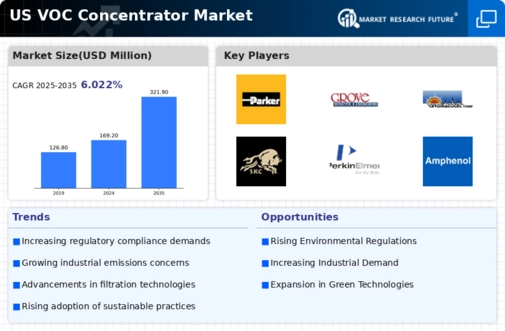Increasing Industrial Emissions
The rise in industrial emissions in the US is a critical driver for the VOC Concentrator Market. As industries expand, the demand for effective air quality management solutions intensifies. Regulatory bodies are imposing stricter emission standards, compelling manufacturers to adopt technologies that can efficiently reduce volatile organic compounds (VOCs). The voc concentrator market is poised to benefit from this trend, as companies seek to comply with regulations while minimizing their environmental footprint. In 2025, the market is projected to grow by approximately 8% due to heightened awareness of air quality issues and the need for advanced emission control technologies. This growth reflects a broader commitment to sustainable practices within the industrial sector.
Rising Awareness of Health Impacts
Growing awareness of the health impacts associated with VOC exposure is a significant driver for the VOC Concentrator Market. As consumers and businesses become more informed about the potential health risks, there is an increasing demand for solutions that mitigate these risks. This trend is particularly evident in sectors such as construction and manufacturing, where VOC emissions are prevalent. The voc concentrator market is likely to expand as companies seek to implement effective air quality management systems to protect their workforce and comply with health regulations. In 2025, the market is anticipated to grow by approximately 7%, reflecting the heightened focus on health and safety in industrial environments.
Government Incentives for Clean Technology
Government incentives aimed at promoting clean technology adoption are playing a pivotal role in the VOC Concentrator Market. Various federal and state programs offer financial support and tax benefits for companies investing in pollution control technologies. These incentives encourage industries to transition towards cleaner operations, thereby increasing the demand for VOC concentrators. The voc concentrator market is expected to benefit from these initiatives, as businesses look to capitalize on available funding to enhance their environmental performance. By 2025, the market could experience a growth rate of around 9%, driven by the favorable regulatory landscape and financial support for clean technology investments.
Technological Innovations in VOC Management
Technological advancements in VOC management are significantly influencing the VOC Concentrator Market. Innovations such as advanced adsorption materials and energy-efficient designs are enhancing the performance of VOC concentrators. These technologies not only improve the efficiency of VOC capture but also reduce operational costs for industries. The integration of smart technologies, such as IoT for real-time monitoring, is also gaining traction. As industries increasingly prioritize efficiency and cost-effectiveness, the voc concentrator market is expected to see a surge in demand. By 2025, the market could witness a growth rate of around 10%, driven by these technological innovations that offer enhanced performance and lower energy consumption.
Shift Towards Sustainable Manufacturing Practices
The shift towards sustainable manufacturing practices is increasingly influencing the VOC Concentrator Market. As industries strive to reduce their environmental impact, there is a growing emphasis on adopting technologies that minimize VOC emissions. This trend is particularly pronounced in sectors such as automotive and consumer goods, where sustainability is becoming a key differentiator. The voc concentrator market is likely to see increased demand as manufacturers seek to align with sustainability goals and consumer expectations. By 2025, the market may grow by approximately 8%, reflecting the broader industry movement towards environmentally responsible practices and the adoption of advanced VOC management solutions.






















Leave a Comment